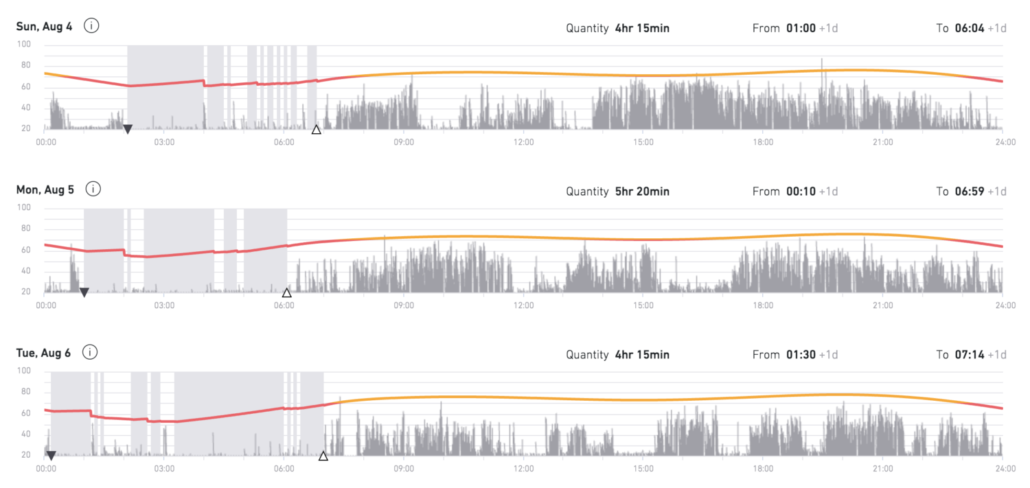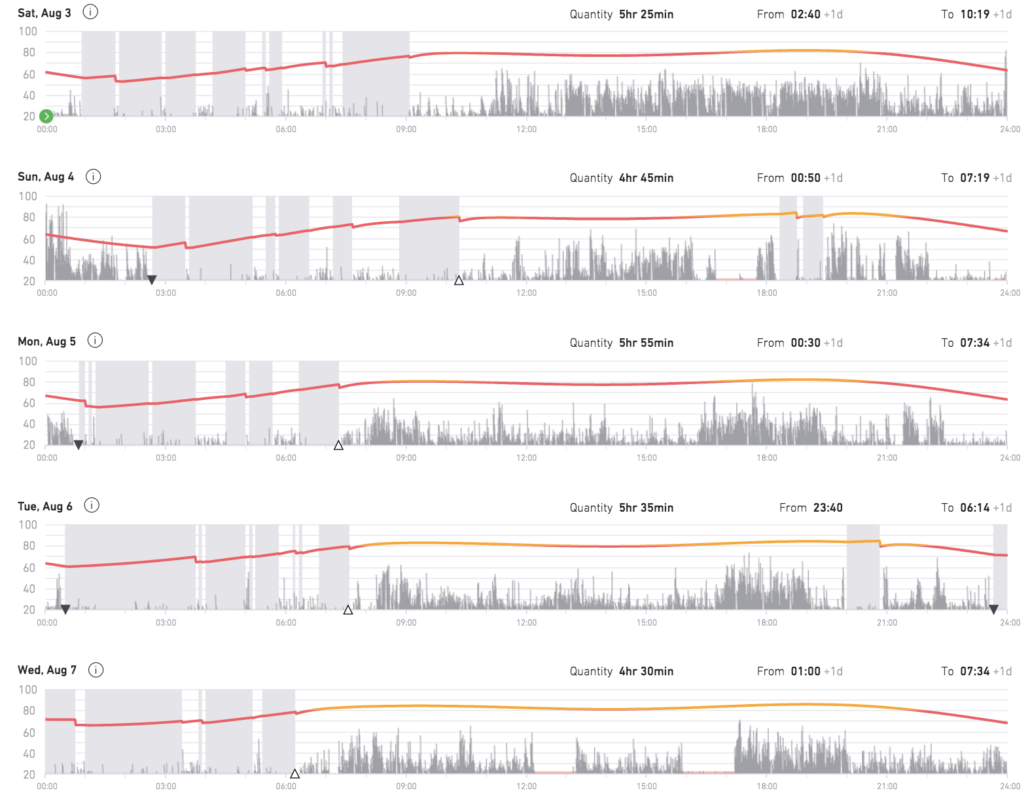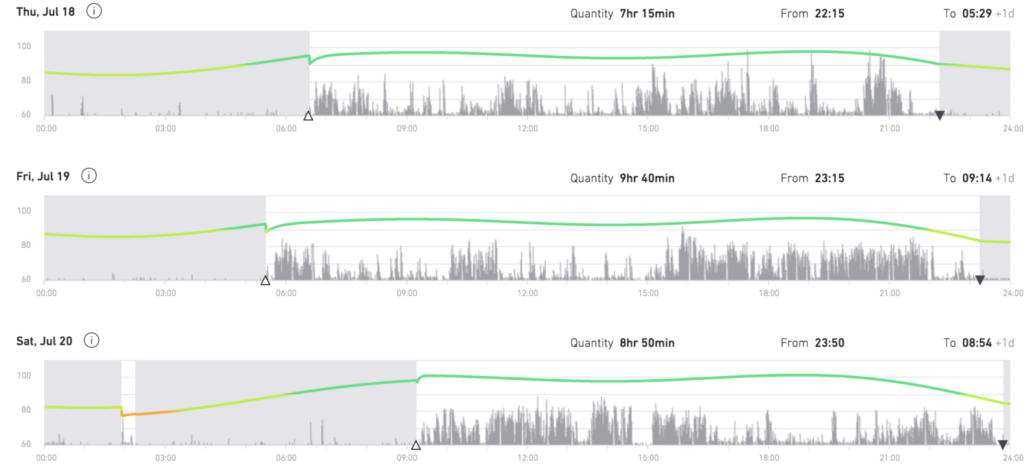The Power of Baseline Sleep Data
Contents
Defining Screening and Understanding a Baseline Reading for Sleep Tracking
Benefits of Capturing Baseline Data
Three Examples of Athlete Baseline Sleep Recordings
Taking Action on Sleep Data and Referring to a Medical Specialist
Start Assessing Sleep and Addressing the Problem
Screening athletes for health and wellness is a growing opportunity for teams and colleges, as regeneration is instrumental to athletic recovery. For years, Fatigue Science has observed an alarming trend: athletes who are not receiving deep, restorative sleep are struggling to stay healthy and perform at their best. While the research and appreciation of sleep is growing, appraising the sleep quality and quantity of athletes requires an actual measurement of athletes. In this article, we will show you how sleep screening works and what can be learned from performing a baseline reading of athletes at the beginning of their season.
Defining Screening and Understanding a Baseline Reading for Sleep Tracking
Medical screening has its limitations and drawbacks, but proactive methods of addressing known problems are the best course of action for teams. If an organization is primed in the potential false negatives and false positives of screening, the process alone will alert both the team and athlete of a sleep problem. The purpose of screening is not necessarily to diagnose a problem, but to find those who are struggling with chronic sleep issues. Non-invasive sleep screening simply tracks an athlete’s sleep over a short period of time and provides insight on who may have a severe sleep disorder. In no way is the process foolproof, but it’s the most practical way of assessing large groups of athletes and creating a dialogue between athletes and staff. Baseline readings are defined as reference points during the initiation of a testing period. Depending on the stage or time period of the year, baseline data may not represent what is normal or typical for the athlete, but sleep screening in the pre-season should still be performed because of the logistical advantage of that time period.
Benefits of Capturing Baseline Sleep Data
The mounting fear of sleep monitoring is the perceived burden of athlete compliance and the energy involved in keeping up with daily data collection. A compelling selling point of baseline data is that the commitment doesn’t need to be indefinite. Support staff can immediately make an impact by identifying a problem. The willingness of athletes to be monitored over short periods of time is realistic and provides a large return on investment. The simple act of measuring invites discussion and communication with multiple parties. Athletes are far more likely to commit to ongoing monitoring after they see immediate feedback and support. Thus, screening over a period of 1-2 weeks is especially effective for making behavioural change. Over this period, athletes can directly see the cause and effect of their decisions as well as outside factors that may improve or decrease sleep performance. Outside the immediate screening of athletes, the long-term benefit of baseline testing year to year demonstrates the value of sleep data to athletes. When athletes see sleep as an important addition to conventional screening, they understand the connection to injuries and performance. Baseline data can also be used later when athletes and support staff want to see how factors such as travel and training are affected. Ideally, athletes should continue sleep monitoring throughout their career, but baseline data profiles the athlete’s routine and possible candidacy for additional interventions.
If used correctly, sleep data can be merged with or compared against other data sets to fully leverage the power of sleep monitoring. In summary, the benefits of baseline data go beyond the screening. It open a new realm of possibilities once athletes see a benefit to their short commitment.
Three Examples of Athlete Baseline Sleep Recordings
Athletes will experience both sleep disturbances and periods of excellent rest over their lifetime. When rest is at a premium during a sport season, monitoring is essential. Generally, athletes fall into three categories of sleep profiles:
- Those who are chronically poor sleepers due to disorders
- Those who sleep enough to get by
- Those who fully tap into the power of sleep
In reality, sleep performance is a spectrum that ranges from clinical insomnia all the way to deep sleep that is fully restorative. Therefore, coaches and support staff need to see where athletes fall on this spectrum and how training and lifestyle affects their baseline scores.

Sleep data showing fractured sleep.
The above example of baseline data, pulled from the Fatigue Science solution, shows fractured sleep that is short and inconsistent. When sleep is impaired such as the athlete above, the risks of both health and performance impairment skyrocket dramatically. Some obvious issues with sleep can be seen in a few nights of recording. Coaches can clearly see life rhythms, such as when athletes wake and when they go to bed, and if they aren’t giving themselves enough time to get a full 8 hours of sleep in. In addition to sleep patterns, fractured sleep can be seen instantly on the team software, showing up as periods of movement and wakefulness. Athletes who are chronically poor sleepers are easily flagged and identified, creating an opportunity to support their sleep impairment or disorder.

Sleep data showing fractured sleep.
Common sleep performance problems are usually small and manageable. Identifying those who are sleep deprived and require deeper and longer sleep periods are possible with baseline monitoring. Common to the general population and athletes alike is the light sleeper who can function but is operating in a small amount of sleep debt. The light sleeper does restore enough to be effective, but they are hardly optimal in performance. Athletes who sleep deeper and longer tend to recover from training better and are less likely to be injured than their sleep-deprived counterparts. Small modifications to life routines often lead to athletes sleeping better and succeeding on the field.

Sleep data showing poorer sleeper.
In the above example, the amount of wake periods is alarming. While a bad night doesn’t mean an athlete has a sleep disorder, repeatedly poor sleep does hint to a potential medical condition.

Sleep data showing good sleeper.
Last is the deep sleeper, who takes advantage of sleep consistently. Their sleep data shows quantity of over 8 hours average, and quality sleep with few periods of waking interruptions. Their training and recovery reflect their commitment, and deep sleepers often find a routine that works and stick to it. Some athletes are born great sleepers, but most benefit from some sort of sleep plan. Nearly all athletes can become deep sleepers if the proper education, monitoring, and support are instilled by their team.
The challenge of sleep monitoring is not the monitoring itself but simply starting the process. Sleep management requires both measurement and monitoring as well as the implementation of treatment or education after analysis. By using daily measures of sleep and modeling fatigue, support staff can truly enhance their training programs.
Taking Action on Sleep Data and Referring to a Medical Specialist
The role of sports performance and sports medical staff is to collect data and provide it to a specialist. A sleep specialist may wish to either interpret the data directly or request a lab assessment overnight if the problem is severe.
Sleep medications and other interventions such as CPAP (continuous positive airway pressure) prescriptions sometimes require overnight analysis. Clinical assessments such as blood analysis and subjective questionnaires are often included. Medical specialists as well as general practitioners should work cohesively together. If the sleep specialist or consultant finds the sleep impairment manageable, usually the next step is focusing on athlete education. Because sleep quality and recovery are multivariate, training plans and nutrition are often part of the formula to improve sleep performance. Sleep is a responsibility of all support staff and athletes, so monitoring and managing sleep trends over the course of a season is paramount. Systematic implementation should include plans and protocols so that athletes have a better chance to respond to interventions.
Start Assessing Sleep and Addressing the Problem
It’s easy to get lost in the available science, but baseline testing is the only way to truly get a handle on athlete sleep. Monitoring sleep and fatigue provides checks and balances with athlete recovery. Proper assessment of sleep is necessary to see both trends and the effects of behavioral change. In order to get the most out of athletes, rest, and specifically deep restorative sleep, needs to be measured. Repeatedly tracking sleep over the course of a season is important, but to start the process and build engagement, teams must perform baseline testing with athletes to create buy-in.
Interested in learning more about data-driven fatigue management?
or download our free eBook on the Science of Sleep for industrial workforces


